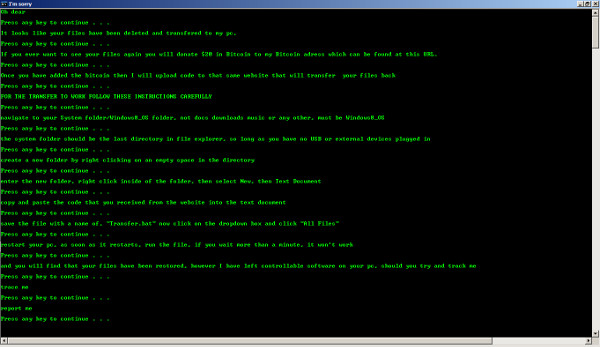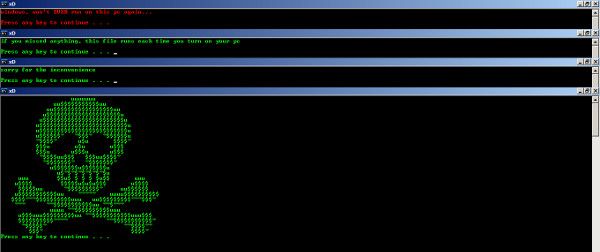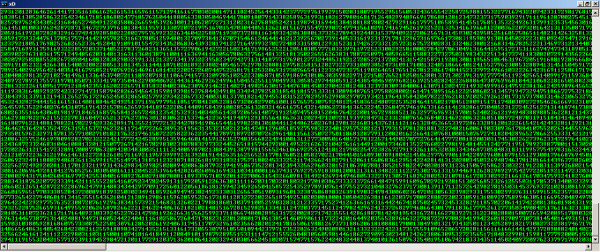RANSOM_BATHIDE.A
Windows


Threat Type: Ransomware
Destructiveness: No
Encrypted: No
In the wild: Yes
OVERVIEW
Downloaded from the Internet, Dropped by other malware
This Ransomware arrives on a system as a file dropped by other malware or as a file downloaded unknowingly by users when visiting malicious sites.
TECHNICAL DETAILS
362,347 bytes
EXE
Yes
27 Mar 2017
Displays message/message boxes
Arrival Details
This Ransomware arrives on a system as a file dropped by other malware or as a file downloaded unknowingly by users when visiting malicious sites.
Installation
This Ransomware adds the following folders:
- %User Temp%\afolder
- %User Temp%\ytmp
(Note: %User Temp% is the user's temporary folder, where it usually is C:\Documents and Settings\{user name}\Local Settings\Temp on Windows 2000, Windows Server 2003, and Windows XP (32- and 64-bit); C:\Users\{user name}\AppData\Local\Temp on Windows Vista (32- and 64-bit), Windows 7 (32- and 64-bit), Windows 8 (32- and 64-bit), Windows 8.1 (32- and 64-bit), Windows Server 2008, and Windows Server 2012.)
It drops the following files:
- %User Temp%\afolder\Ransomware.exe - SFX archive containing Encrypt.exe and Display.exe
- %User Temp%\ytmp\t{random numbers}.bat - batch files that display ransom note and hide files
- %User Temp%\ytmp\t{random numbers}.exe - not an executable, contains the text “RCHELICOPTERFTW”
(Note: %User Temp% is the user's temporary folder, where it usually is C:\Documents and Settings\{user name}\Local Settings\Temp on Windows 2000, Windows Server 2003, and Windows XP (32- and 64-bit); C:\Users\{user name}\AppData\Local\Temp on Windows Vista (32- and 64-bit), Windows 7 (32- and 64-bit), Windows 8 (32- and 64-bit), Windows 8.1 (32- and 64-bit), Windows Server 2008, and Windows Server 2012.)
Autostart Technique
This Ransomware drops the following file(s) in the Windows User Startup folder to enable its automatic execution at every system startup:
- C:\Users\{username}\AppData\Roaming\Microsoft\Windows\Start Menu\Programs\Startup\Encrypt.exe - creates and executes a batch file to hide files
- C:\Users\{username}\AppData\Roaming\Microsoft\Windows\Start Menu\Programs\Startup\Display.exe - creates and executes a batch file to display ransom note
Other Details
This Ransomware does the following:
- It opens the following link in the system's default browser:
http://{BLOCKED}xthost.in/146994 - It targets files to hide in the following directories:
- C:\Users\{username}\Desktop
- C:\Users\{username}\Documents
- C:\Users\{username}\Downloads
- C:\Users\{username}\Music
- C:\Users\{username}\Pictures
- C:\Users\{username}\Videos
NOTES:
It displays the ransom note with the following content:



SOLUTION
9.850
13.302.09
28 Mar 2017
13.303.00
29 Mar 2017
Step 1
Before doing any scans, Windows XP, Windows Vista, and Windows 7 users must disable System Restore to allow full scanning of their computers.
Step 2
Note that not all files, folders, and registry keys and entries are installed on your computer during this malware's/spyware's/grayware's execution. This may be due to incomplete installation or other operating system conditions. If you do not find the same files/folders/registry information, please proceed to the next step.
Step 3
Restart in Safe Mode
Step 4
Search and delete these files
- C:\Users\{username}\AppData\Roaming\Microsoft\Windows\Start Menu\Programs\Startup\Encrypt.exe
- C:\Users\{username}\AppData\Roaming\Microsoft\Windows\Start Menu\Programs\Startup\Display.exe
- %User Temp%\afolder\Ransomware.exe
- %User Temp%\ytmp\t{random numbers}.bat
- %User Temp%\ytmp\t{random numbers}.exe
Step 5
Search and delete this folder
- %User Temp%\afolder
- %User Temp%\ytmp
Step 6
- Open a command prompt.
- For Windows 2000, Windows XP, and Windows Server 2003 users, click Start>Run. In the Search box, type CMD then press Enter.
- For Windows Vista, Windows 7, and Windows Server 2008 users, click Start, type CMD in the Search input field then press Enter.
- For Windows 8, Windows 8.1, and Windows Server 2012 users, right-click on the lower-left corner of the screen, click Command Prompt.
- In the CMD console, type the following:
ATTRIB [+R | -R] [+A | -A ] [+S | -S] [+H | -H] [+I | -I] [drive:][path][file name] [/S [/D] [/L]]
Where:
+ Sets an attribute.
- Clears an attribute
R Read-only file attribute
A Archive file attribute
S System file attribute
H Hidden file attribute
I Not content indexed file attribute
[drive:][path][filename]
Specifies a file or files for attrib to process
/S Processes matching files in the current folder and all subfolders.
/D Processes folders
/L Work on the attributes of the Symbolic Link versus the target of the Symbolic Link
Example:
To unhide all files and folders (including subfolders) in drive D:
ATTRIB –H D:\* /S /D
- Repeat Step 3 for folders and files in other drives or folders.
Step 7
Restart in normal mode and scan your computer with your Trend Micro product for files detected as RANSOM_BATHIDE.A. If the detected files have already been cleaned, deleted, or quarantined by your Trend Micro product, no further step is required. You may opt to simply delete the quarantined files. Please check this Knowledge Base page for more information.
Did this description help? Tell us how we did.
